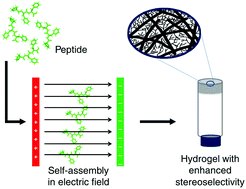Electric field modulated peptide based hydrogel nanocatalysts†
Abstract
The ability to modulate self-assembly is the key to manufacture application-oriented materials. In this study, we investigated the effect of three independent variables that can modulate the catalytic activity of self-assembling peptides. The first two variables, amino acid sequence and its stereochemistry, were examined for their specific roles in the epitaxial growth and hydrogelation properties of a series of catalytic tripeptides. We observed that aromatic π–π interactions that direct the self-assembly of designed peptides, and the catalytic properties of hydrogels, are governed by the position and chirality of the proline residue. Subsequently, the influence of the third variable, an external electric field, was also tested to confirm its catalytic efficiency for the asymmetric C–C bond-forming aldol reaction. In particular, the electric field treated pff and PFF gels showed 10 and 36% higher stereoselectivity, respectively, compared with the control. Structure–property analysis using CD and FTIR spectroscopy indicates the electric field-induced beta to non-beta conformational transition in the peptide secondary structure, which corroborates with its reduced cross-link density and fibril width, respectively. Amplitude sweep rheology of the gels suggests a decrease in the storage modulus, with increased field strength. The results showed that an electric field of optimal strength can modulate the physical characteristics of the hydrogel, which in turn is manifested in the observed difference in enantioselectivity.

- This article is part of the themed collection: Soft Matter Editor-in-Chief's Choice


 Please wait while we load your content...
Please wait while we load your content...